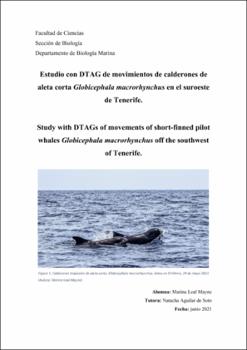Estudio con DTAG de movimientos de calderones de aleta corta Globicephala macrorhynchus en el suroeste de Tenerife.
Autor
Leal Mayne, MarinaFecha
2021Resumen
Short-finned pilot whales (Globicephala macrorhynchus) present in the southwest of
Tenerife one of the five known resident populations of this specie in the world. Despite
this importance, its use of the habitat in the area is still very unknown, so we proposed
this study to analyze the movements of the animals, collecting the data with DTAGs.
We represented the routes of 5 individuals tagged in 2019 (pw19_078a and b) and 2021
(pw21_062a, b and c). The sound samples from pw21_062a and pw21_062c were also
analyzed to relate the buzzes (indicators of prey capture attempts), made by the animal,
with its geographic movements. It was observed that: i) they travel maximum
geographic distances that average 1 km per hour of tag recording duration, frequently
turning towards the initial zones of occurrence; ii) they normally inhabit waters with
depths greater than 700 m, reaching 2000, iii) their movements are relatively parallel to
the coast, separating from it when the isobaths do; iv) during linear movements they
also feed; and v) tagged animals in a social group follow a general pattern of geographic
movement, consistent with their strong social cohesion. Los calderones de aleta corta (Globicephala macrorhynchus) presentan en el suroeste de
Tenerife una de las cinco poblaciones residentes conocidas de la especie en el mundo.
Pese a esta importancia, su uso del hábitat en el área es muy desconocido, por lo que
nos planteamos este estudio para analizar los movimientos de los animales, recopilando
los datos con marcas DTAG. Representamos los recorridos de 5 individuos marcados en
2019 (pw19_078a y b) y 2021 (pw21_062a, b y c). También se analizaron las muestras
de sonido del pw21_062a y del pw21_062c para relacionar los zumbidos (indicadores
de intentos de captura de presa), hechos por el animal, con sus movimientos
geográficos. Se observó que: i) recorren distancias máximas geográficas que ascienden
de media 1 km por hora de duración del marcaje, girando frecuentemente hacia las
zonas iniciales de ocurrencia; ii) habitan normalmente en aguas con profundidades
superiores a los 700 m, llegando a los 2000, iii) sus movimientos son relativamente
paralelos a la costa, separándose de la misma cuando lo hacen las isóbatas; iv) durante
los movimientos lineales también se alimentan; y v) los animales marcados en un grupo
social siguen un patrón general de movimiento geográfico, consistente con su fuerte
cohesión social.





